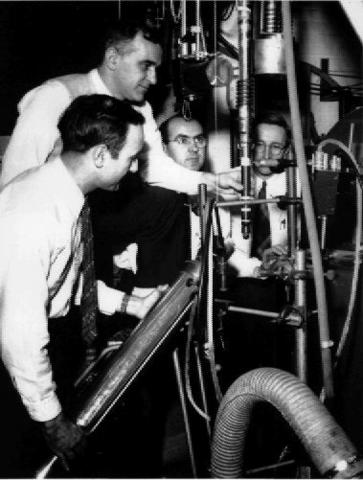The Fall of Parity

Physicists assemble low-temperature equipment used in experiments which disproved the principle of conservation of parity in nuclear physics. The vertical tube (upper right) contained radioactive cobalt-60, a beta-ray counter, and a temperature measuring device. A vacuum flask (lower left) is being placed around the tube to help keep it at a low temperature.
The Discovery that Parity is Not Conserved
Between Christmas of 1956 and New Year's Day, the first exciting results emerged from a difficult but fundamental scientific experiment at the National Bureau of Standards (NBS) in Washington, DC [currently the National Institute of Standards and Technology (NIST)]. The experiment showed, strikingly and convincingly, that in at least one fundamental physical process, our world is distinguishable from its mirror image. Physicists had long assumed the opposite. They constructed their theories so as to ensure that the corresponding mathematical property, called parity, remains unaltered - is conserved - in all subatomic processes. Thus this experiment brought about the fall of parity from its exalted position alongside such well conserved physical quantities as energy, momentum, and electric charge.
Contents:
- Parity: What's Not Conserved?
- Descriptive Explanation of the Experiment
- Photo Gallery with Short Biographies
- Experimentalists:
- Chien-Shiung Wu
- Ernest Ambler
- Raymond W. Hayward
- Dale D. Hoppes
- Ralph P. Hudson
- Theorists:
- Tsung Dao Lee
- Chen Ning Yang
- Experimentalists:
Exhibit designed by W. C. Martin, J. Coursey, and R.A. Dragoset
This exhibit was prepared by the NIST Physics Laboratory (now part of PML) as a project of the NIST Museum Committee. It is one of the exhibit panels in the NIST Virtual Museum.
Much of the experimental apparatus for the experiment described here was reassembled with the help of Raymond Hayward and Bruce Dove for an exhibit entitled "The Fall of Parity" shown at the National Museum of American History (NMAH) in Washington, DC, during 1982 to mark the 25th anniversary of the experiment. That exhibit with the apparatus is now in the NIST Museum in Gaithersburg, MD on long-term loan from NMAH.
The title, introductory paragraph, "Parity: What's Not Conserved?" and certain other material in the exhibit presented here are taken from, or based on, the NMAH exhibit by Paul Forman, curator for modern physics at NMAH, Smithsonian Institution. The "Descriptive Explanation of the Experiment" is largely taken from an account published in the NBS Technical News Bulletin, Vol. 41, No. 4 (April 1957). Raymond Hayward, Ralph Hudson, and Michael Danos gave advice and were helpful in other ways in the preparation of this exhibit. Michelle Hane provided assistance in producing some of the documents in HTML code.
Online: July 1997

